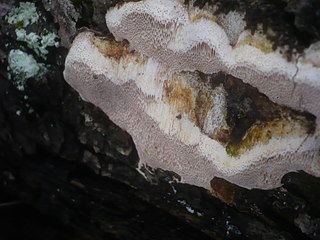
The Russulales are an order of the Agaricomycetes,. According to the Dictionary of the Fungi, the order consists of 12 families, 80 genera, and 1767 species. According to Species Fungorum, the order contains 13 families, 117 genera, and 3,060 species.

The Polyporales are an order of about 1800 species of fungi in the division Basidiomycota. The order includes some polypores as well as many corticioid fungi and a few agarics. Many species within the order are saprotrophic, most of them wood-rotters. Some genera, such as Ganoderma and Fomes, contain species that attack living tissues and then continue to degrade the wood of their dead hosts. Those of economic importance include several important pathogens of trees and a few species that cause damage by rotting structural timber. Some of the Polyporales are commercially cultivated and marketed for use as food items or in traditional Chinese medicine.

Polypores are a group of fungi that form large fruiting bodies with pores or tubes on the underside. They are a morphological group of basidiomycetes-like gilled mushrooms and hydnoid fungi, and not all polypores are closely related to each other. Polypores are also called bracket fungi or shelf fungi, and they characteristically produce woody, shelf- or bracket-shaped or occasionally circular fruiting bodies that are called conks.

Perenniporia is a cosmopolitan genus of bracket-forming or crust-like polypores in the family Polyporaceae. They are dimitic or trimitic with smooth, thick-walled basidiospores and cause a white rot in affected wood.
Perenniporia podocarpi is a species of resupinate (encrusting) polypore. It occurs widely but uncommonly on the New Zealand endemic podocarps Dacrydium cupressinum and Prumnopitys taxifolia. Basidiocarps are dimitic and grow up to 9 cm across, thick and cushion-like with a distinctive white or very pale cream spore surface with large pores. The basidiospores are extremely large for the genus, up to 27 μm in length.

Meripilus giganteus is a polypore fungus in the family Meripilaceae. It causes a white rot in various types of broadleaved trees, particularly beech (Fagus), but also Abies, Picea, Pinus, Quercus and Ulmus species. This bracket fungus, commonly known as the giant polypore or black-staining polypore, is often found in large clumps at the base of trees, although fruiting bodies are sometimes found some distance away from the trunk, parasitizing the roots. M. giganteus has a circumboreal distribution in the northern Hemisphere, and is widely distributed in Europe. In the field, it is recognizable by the large, multi-capped fruiting body, as well as its pore surface that quickly darkens black when bruised or injured.

Postia is a genus of brown rot fungi in the family Fomitopsidaceae.

Ceriporia is a widely distributed genus of crust fungi.

Antrodiella is a genus of fungi in the family Steccherinaceae of the order Polyporales.
Diacanthodes is a genus of three species of poroid fungi in the family Meruliaceae.
Megasporoporia is a genus of four species of crust fungi in the family Polyporaceae. The genus is characterized by its large spores, and dextrinoid skeletal hyphae.

Skeletocutis is a genus of about 40 species of poroid fungi in the family Polyporaceae. The genus has a cosmopolitan distribution, although most species are found in the Northern Hemisphere. It causes a white rot in a diverse array of woody substrates, and the fruit bodies grow as a crust on the surface of the decaying wood. Sometimes the edges of the crust are turned outward to form rudimentary bracket-like caps.

Tyromyces is a genus of poroid fungi in the family Polyporaceae. It was circumscribed by mycologist Petter Karsten in 1881. The type species is the widely distributed Tyromyces chioneus, commonly known as the white cheese polypore. The phylogenetic position of Tyromyces within the Polyporales is uncertain, but it appears that it does not belong to the "core polyporoid clade". Tyromyces is polyphyletic as it is currently circumscribed, and has been described as "a dumping place for monomitic white-rot species with thin-walled spores."

Bondarzewia is a widely distributed genus of fungi in the family Bondarzewiaceae. The genus was circumscribed by mycologist Rolf Singer in 1940.
Trichaptum podocarpi is a species of fungus in the order Hymenochaetales. It differs from species in its genus by having totally resupinate basidiocarps, distinctly long cystidia, and in its habitat on Podocarpus. It was first isolated from China.

Bondarzewia berkeleyi, commonly known as Berkeley's polypore, or stump blossoms, is a species of polypore fungus in the family Russulaceae. It is a parasitic species that causes butt rot in oaks and other hardwood trees. A widespread fungus, it is found in Africa, Asia, Europe, and North America.
Bondarzewia guaitecasensis is a species of polypore fungus in the family Russulaceae that is found in South America. Originally described as Polyporus guaitecasensis by German mycologist Paul Christoph Hennings in 1900, it was transferred to the genus Bondarzewia by Jorge Eduardo Wright in 1964. The fungus is parasitic on species of Nothofagus.

Bondarzewia mesenterica is a species of polypore fungus in the family Bondarzewiaceae. It was first described as Boletus mesentericus by Jacob Christian Schäffer in 1774. Hanns Kreisel transferred it to the genus Bondarzewia in 1984. The species is edible.
Bondarzewia tibetica is a species of polypore fungus in the family Bondarzewiaceae. Found in Tibet, it was described as new to science in 2016.
Bondarzewia kirkii is a species of polypore fungus in the family Russulaceae that is endemic to the beech forests of New Zealand.











